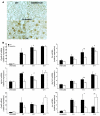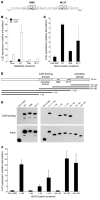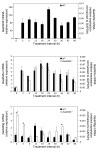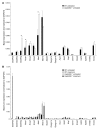Gadd45β is an inducible coactivator of transcription that facilitates rapid liver growth in mice
- PMID: 21965327
- PMCID: PMC3204825
- DOI: 10.1172/JCI38760
Gadd45β is an inducible coactivator of transcription that facilitates rapid liver growth in mice
Abstract
The growth arrest and DNA damage-inducible 45 (Gadd45) proteins act in many cellular processes. In the liver, Gadd45b (encoding Gadd45β) is the gene most strongly induced early during both compensatory regeneration and drug-induced hyperplasia. The latter response is associated with the dramatic and rapid hepatocyte growth that follows administration of the xenobiotic TCPOBOP (1,4-bis[2-(3,5)-dichoropyridyloxy] benzene), a ligand of the nuclear receptor constitutive androstane receptor (CAR). Here, we have shown that Gadd45b-/- mice have intact proliferative responses following administration of a single dose of TCPOBOP, but marked growth delays. Moreover, early transcriptional stimulation of CAR target genes was weaker in Gadd45b-/- mice than in wild-type animals, and more genes were downregulated. Gadd45β was then found to have a direct role in transcription by physically binding to CAR, and TCPOBOP treatment caused both proteins to localize to a regulatory element for the CAR target gene cytochrome P450 2b10 (Cyp2b10). Further analysis defined separate Gadd45β domains that mediated binding to CAR and transcriptional activation. Although baseline hepatic expression of Gadd45b was broadly comparable to that of other coactivators, its 140-fold stimulation by TCPOBOP was striking and unique. The induction of Gadd45β is therefore a response that facilitates increased transcription, allowing rapid expansion of liver mass for protection against xenobiotic insults.
Figures








Similar articles
-
Gadd45beta is induced through a CAR-dependent, TNF-independent pathway in murine liver hyperplasia.Hepatology. 2005 Nov;42(5):1118-26. doi: 10.1002/hep.20883. Hepatology. 2005. PMID: 16231353
-
Gadd45 in the liver: signal transduction and transcriptional mechanisms.Adv Exp Med Biol. 2013;793:69-80. doi: 10.1007/978-1-4614-8289-5_5. Adv Exp Med Biol. 2013. PMID: 24104474 Review.
-
Nuclear receptor CAR represses TNFalpha-induced cell death by interacting with the anti-apoptotic GADD45B.PLoS One. 2010 Apr 12;5(4):e10121. doi: 10.1371/journal.pone.0010121. PLoS One. 2010. PMID: 20404936 Free PMC article.
-
The antiapoptotic factor growth arrest and DNA-damage-inducible 45 beta regulates the nuclear receptor constitutive active/androstane receptor-mediated transcription.Drug Metab Dispos. 2008 Jul;36(7):1189-93. doi: 10.1124/dmd.108.020628. Epub 2008 Mar 24. Drug Metab Dispos. 2008. PMID: 18362160 Free PMC article.
-
Contradictory Role of Gadd45β in Liver Diseases.J Cell Mol Med. 2024 Dec;28(23):e70267. doi: 10.1111/jcmm.70267. J Cell Mol Med. 2024. PMID: 39653679 Free PMC article.
Cited by
-
Med1 subunit of the mediator complex in nuclear receptor-regulated energy metabolism, liver regeneration, and hepatocarcinogenesis.Gene Expr. 2014;16(2):63-75. doi: 10.3727/105221614X13919976902219. Gene Expr. 2014. PMID: 24801167 Free PMC article. Review.
-
Targeting xenobiotic receptors PXR and CAR for metabolic diseases.Trends Pharmacol Sci. 2012 Oct;33(10):552-8. doi: 10.1016/j.tips.2012.07.003. Epub 2012 Aug 10. Trends Pharmacol Sci. 2012. PMID: 22889594 Free PMC article. Review.
-
RNA-Seq reveals common and unique PXR- and CAR-target gene signatures in the mouse liver transcriptome.Biochim Biophys Acta. 2016 Sep;1859(9):1198-1217. doi: 10.1016/j.bbagrm.2016.04.010. Epub 2016 Apr 23. Biochim Biophys Acta. 2016. PMID: 27113289 Free PMC article.
-
Gadd45 in DNA Demethylation and DNA Repair.Adv Exp Med Biol. 2022;1360:55-67. doi: 10.1007/978-3-030-94804-7_4. Adv Exp Med Biol. 2022. PMID: 35505162
-
TCPOBOP-Induced Hepatomegaly and Hepatocyte Proliferation are Attenuated by Combined Disruption of MET and EGFR Signaling.Hepatology. 2019 Apr;69(4):1702-1718. doi: 10.1002/hep.30109. Epub 2018 Dec 31. Hepatology. 2019. PMID: 29888801 Free PMC article.
References
-
- Ledda-Columbano GM, Pibiri M, Loi R, Perra A, Shinozuka H, Columbano A. Early increase in cyclin-D1 expression and accelerated entry of mouse hepatocytes into S phase after administration of the mitogen 1, 4-Bis[2- (3,5-Dichloropyridyloxy)] benzene. Am J Pathol. 2000;156(1):91–97. doi: 10.1016/S0002-9440(10)64709-8. - DOI - PMC - PubMed
Publication types
MeSH terms
Substances
Grants and funding
LinkOut - more resources
Full Text Sources
Other Literature Sources
Molecular Biology Databases
Miscellaneous

